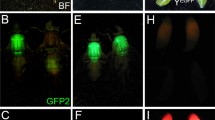Abstract
The persistence of DNA injected into two species of adult female phytoseiids and its transmission to serial eggs deposited by them was assessed by the polymerase chain reaction (PCR). The effect of DNA concentration on persistence and transmission was examined in Metaseiulus occidentalis. M. occidentalis females were microinjected with plasmid DNA at three different concentrations (250, 500, 750 ng μL−1) and allowed to deposit one to five eggs before the females and their last eggs were analyzed. Plasmid DNA was found in 82% of the females assayed and in 70% of all the eggs analyzed (including the fifth eggs produced after microinjection). Transmission of DNA to multiple eggs was also examined in Amblyseius finlandicus. Females of this species are less traumatized by microinjection allowing analysis of transmission over a more extended number of eggs. Females were microinjected and allowed to deposit eggs until their death. DNA from every fifth egg was analyzed by the PCR. PCR products were amplified from 51% of the eggs and from all egg classes except the 30th egg. The persistence and presence of plasmid DNA in both eggs and females suggests that (1) maternal microinjection is a more efficient method for DNA delivery than traditional egg microinjection, (2) it may be possible to isolate transformants from fewer maternally-microinjected females than originally expected, and (3) maternal microinjection could be useful as a DNA delivery system in other phytoseiids.
Similar content being viewed by others
References
Beckendorf, S. K. and M. A. Hoy. 1985. Genetic improvement of arthropod natural enemies through selection, hybridization or genetic engineering techniques. In: M. A. Hoy and D. C. Herzog [Editors], Biological Control in Agricultural IPM Systems. Academic Press, Orlando, pp. 167–187.
Edwards, O. R. and M. A. Hoy. 1993. Polymorphism in two parasitoids detected using random amplified polymorphic DNA (RAPD) PCR. Biological Control. 3: 243–257.
Handler, A. M. and D. A. O'Brochta. 1991. Prospects for gene transformation in insects. Annu. Rev. Entomol. 36: 159–183.
Hoy, M. A. 1982. Genetics and genetic improvement of the Phytoseiidae. In: M. A. Hoy [Editor] Recent Advances in Knowledge of the Phytoseiidae. University of California Div. Agric. Nat. Res. Publ. No. 3284, Berkeley, pp. 72–89.
Hoy, M. A. 1993. Transgenic beneficial arthropods for pest management programs: an assessment of their practicality and risks. In: Robert D. Lumsden and James L. Vaughn (Editors), Pest Management: Biologically Based Technologies. American Chemical Society Proceedings series. pp. 357–369.
Hoy, M. A. and K. A. Standow. 1982. Inheritance of resistance to sulfur in the spider mite predator Metaseiulus occidentalis. Entomol. Exp. Appl. 31: 316–323.
Lawrence, P. A. 1992. The Making of a Fly. The Genetics of Animal Design, Blackwell Scientific Publications, London.
Mathi, S. K., V. K. Walker and G. R. Wyatt. 1991. Expression from two Drosophila promoters in embryos of the migratory locust. Insect Biochem. 21(6): 623–629.
McGrane, V., J. O. Carlson, B. R. Miller and B. J. Beaty. 1988. Microinjection of DNA into Aedes triseriatus ova and detection of integration. Am. J. Trop. Med. Hyg. 39: 502–510.
McInnis, D. O., D. S. Haymer, S. Y. T. Tam and S. Thanaphum. 1990. Ceratitis capitata (Diptera: Tephritidae): transient expression of a heterologous gene for resistance to the antibiotic geneticin. Ann. Entomol. Soc. Am. 83: 982–986.
Miller, L. H., R. K. Sakai, P. Romans, W. Gwadz, P. Kantoff and H. G. Coon, 1987. Stable integration and expression of a bacterial gene in the mosquito Anopheles gambiae. Science 237: 779–781.
Mismer, D. and G. M. Rubin. 1987. Analysis of the promoter of the ninaE opsin gene in Drosophila melanogaster. Genetics 116: 565–578.
Morris, A. C., P. Eggleston and J. M. Crampton. 1989. Genetic transformation of the mosquito Aedes aegypti by micro-injection of DNA. Med. Vet. Entomol. 3: 1–7.
Presnail, J. K. and M. A. Hoy. 1992. Stable genetic transformation of a beneficial arthropod by microinjection. Proc. Natl. Acad. Sci. USA 89: 7732–7736.
Roush, R. T. and M. A. Hoy. (1981) Genetic improvement of Metaseiulus occidentalis: Selection with methomyl, dimethoate, and carbaryl and genetic analysis of carbaryl resistance. J. Econ. Entomol. 74: 138–141.
Rubin, G. M. and A. C. Spradling. 1982. Genetic transformation of Drosophila with transposable element vectors. Science 218: 348–353.
Sechser, B., P. Thueler, and A. Bachmann. 1984. Observations on population levels of the European red mite (Acarina, Tetranychidae) and associated arthropod predator complexes in different spray programs over a 5-year period. Environ. Entomol. 13:(6) 1577–1582.
Schausberger, V. P. 1992. Vergleichende untersuchungen uber den einflub unterschiedlicher nahrung auf die praimaginalentwicklung und die reproduktion von Amblyseius aberrans Oud. und Amblyseius finlandicus Oud. (Acarina, Phytoseiidae). J. Appl. Entomol. 113: 476–486.
Schubbert, R., C. Lettmann, and W. Doerfler. 1994. Ingested foreign (phage M13) DNA survives transiently in the gastrointestinal tract and enters the bloodstream of mice. Mol. Gen. Genet. 242: 495–504.
Spradling, A. C. and G. M. Rubin. 1982. Transposition of cloned P elements into Drosophila germline chromosomes. Science 218: 341–347.
Steller, H. and V. Pirrotta. 1985. Fate of DNA injected into early Drosophila embryos. Developmental Biology 109: 54–62.
Walker, V. K. 1989. Gene transfer in insects. Adv. Cell Culture 7: 87–124.
Wolff, J. A., R. W. Malone, P. Williams, W. Chong, G. Acsadi, A. Jani and P. L. Felgner. 1990. Direct gene transfer into mouse muscle in vivo. Science 247: 1465–1468.
Author information
Authors and Affiliations
Rights and permissions
About this article
Cite this article
Presnail, J.K., Hoy, M.A. Transmission of injected DNA sequences to multiple eggs of Metaseiulus occidentalis and Amblyseius finlandicus (Acari: Phytoseiidae) following maternal microinjection. Exp Appl Acarol 18, 319–330 (1994). https://doi.org/10.1007/BF00116313
Accepted:
Issue Date:
DOI: https://doi.org/10.1007/BF00116313



